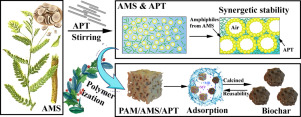Abstract
The water-based foam stabilized by the natural surfactant applied in the fabrication of porous materials has attracted extensive attention, as the advantages of cleanness, con-venience and low cost. Particularly, the development of a green preparation method has became the main research focus and frontier. In this work, a green liquid foam with high sta-bility was prepared by synergistic stabilization of natural plant astragalus membranaceus (AMS) and attapulgite (APT), and then a novel porous material with sufficient hierarchi-cal pore structure was templated from the foam via a simple free radical polymerization of acrylamide (AM). The characterization results revealed that the amphiphilic molecules from AMS adsorbed onto the water-air interface and formed a protective shell to prevent the bubble breakup, and APT gathered in the plateau border and formed a three-dimensional network structure, which greatly slowed down the drainage rate. The porous material polyacrylamide/astragalus membranaceus/attapulgite (PAM/AMS/APT) showed the excel-lent adsorption performance for cationic dyes of Methyl Violet (MV) and Methylene Blue (MB) in water, and the maximum adsorption capacity could reach to 709.13 and 703.30 mg/g, respectively. Furthermore, the polymer material enabled to regenerate and cycle via a con-venient calcination process, and the adsorption capacity was still higher than 200 mg/g after five cycles. In short, this research provided a new idea for the green preparation of porous materials and the treatment of water pollution.(c) 2022 The Research Center for Eco-Environmental Sciences, Chinese Academy of Sciences. Published by Elsevier B.V.

Keywords Plus:INTERNAL PHASE EMULSIONSMETHYLENE-BLUEANGELICA-SINENSISPICKERING FOAMSADSORPTIONSAPONINSSURFACEPOLYSACCHARIDESVISCOELASTICITYOIL
Published in JOURNAL OF ENVIRONMENTAL SCIENCES,Volume127;10.1016/jjes.2022.08.004,MAY 2023


